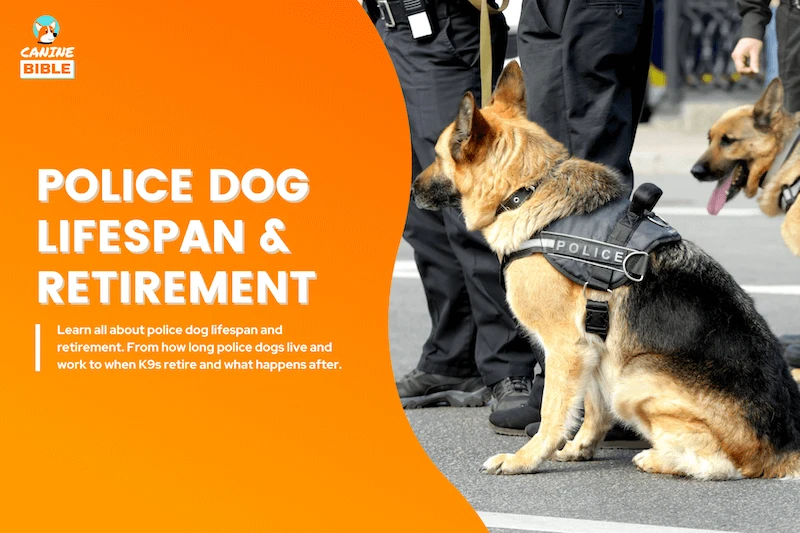Police Dog Lifespan: How Long K9s Work, Live & Retirement Age?

Canine Bible is reader-supported. We receive affiliate commissions via some of our links. This doesn’t affect rankings. Learn more.
Police dog lifespan expectancy is defined as the expected number of working years of a K9 unit. Various factors, including breed, health status, and job-related risks influence police dog lifespan. While it’s difficult to predict the exact working lifespan and retirement age of a K9 unit due to these variables, a police dog typically serves between 8 to 10 years from the time they begin their training as a K9 officer. However, their careers can be shortened unexpectedly due to the inherent dangers associated with their duties.
Police dogs, often called K9 units, play an indispensable role in law enforcement agencies worldwide. These specially trained dogs assist in various critical tasks, including drug and explosives detection, search and rescue operations, crime scene investigations, and suspect apprehension.
If you are planning to adopt a retired police dog or work with one, understanding the lifespan and working life of police dogs is crucial for several reasons we lay out in this article. There are also important considerations to remember. Read on to learn how long police dogs live and work, retirement age, care tips, and more.
What Is The Average Lifespan of a Police Dog?
The average lifespan of a police dog varies depending on the breed, but most police dogs typically live between 8 and 15 years. However, being a police dog is a very demanding and dangerous job that can affect the dog’s body and even its own life. Police dogs risk their lives every day and can die early on duty. We’ve seen fallen K9s that have passed at 3, 5, and 6 years of age.
For a more accurate result, we calculated the average lifespan of the most popular police dog breeds. On average, you can expect police dogs to live 11.5 years. This calculation considers the typical lifespan ranges for each breed in the table below and finds the mean across all of them.
Police Dog Lifespan By Breed
| Breed | Lifespan | K9 Job Description |
|---|---|---|
| German Shepherd | 9 to 13 years | Excellent trackers specializing in tracking missing people. |
| Beagle | 9 to 15 years | Primarily used in airports and harbors to sniff out drugs and illegal substances, effective at sniffing out packaged narcotics. |
| Belgian Malinois | 12 to 14 years | Smaller than German Shepherds but quick to react, making them perfect for unexpected chases and take-downs. |
| Boxer | 9 to 15 years | Loyal, stable, and friendly, but their use as police dogs has declined due to a genetic inclination toward certain illnesses. |
| Bloodhound | 9 to 11 years | Recognized worldwide as bomb and narcotics detection dogs, they are especially useful in crowded airports or harbors. |
| Labrador Retriever | 10 to 14 years | They are used as protection police dogs, though their appearance might not suggest so. |
| Doberman Pinscher | 10 to 13 years | Intimidating appearance, solid structure, great for apprehending fleeing criminals. |
| Bouvier des Flandres | 10 to 12 years | Perfect for tracking down missing people or corpses, tenacious and determined. |
| German Shorthaired Pointer | 12 to 14 years | They are mostly seen overseas. They are relentless and suspicious of strangers, making them great for tracking suspects and missing people. They are mostly bombs and narcotics. |
| Giant Schnauzer | 10 to 12 years | They are mostly seen overseas. They are relentless and suspicious of strangers, making them great for tracking suspects, missing persons, bombs, and narcotics. |
| American Pit Bull Terrier | 8 to 15 years | Among the latest additions to police dog breeds, their presence alone is imposing and can intimidate anyone. Patrolling and detection are their primary functions. |
| Rottweiler | 8 to 12 years | They are known for their physical abilities and have one of the strongest canine bites. |
| Airedale Terrier | 12 years | Known as “The King of the Terriers,” used primarily as patrol dogs in the U.S. and Europe, athletic and faithful. |
| Cane Corso | 10 to 12 years | Known for assisting police officers and law enforcement in sniffing out drugs or bombs, leading officers to missing people. |
| Basset Hound | 11 to 12 years | Known for assisting police officers and law enforcement in sniffing out drugs or bombs, leading officers to missing people. |
How Long Do Police Dogs Work?
According to the National Police Dog Foundation, a dog’s age when they can begin to work as a police dog is between 12 and 15 months (roughly 1.3 years). That’s usually when dogs reach maturity and can concentrate on training. The working lifespan of a police dog can vary depending on various factors, such as breed, health, and the type of work they do. However, the average working lifespan of a police dog is roughly 8 to 10 years from the moment they are enlisted to become a K9 officer.
What Age Do Police Dogs Retire?
How old is the average police dog when retired? Generally, police departments prefer to retire dogs around 9 years old, states K9 COP magazine. Some dogs may be able to work for longer, while others may need to retire earlier due to health issues or declining performance. Also, some breeds tend to have longer lifespans than others, which may delay K9 retirement in some cases.
Police Dog Lifespan By Life Stages
| Life Stage | Lifespan Estimate | Retirement Age Estimation | Job Description | Other Details |
|---|---|---|---|---|
| Puppyhood | 0-1 year | N/A | Basic socialization and introduction to training environments. | Focus on developing confidence, handling, and basic commands. |
| Adolescence | 1-3 years | N/A | Advanced training in specific skills like tracking or detection. | Training intensifies; dogs may begin early field experiences. |
| Early Working | 3-6 years | N/A | Full deployment in field operations such as patrols, detection, or crowd control. | Peak physical condition; highly active in operations. |
| Mature Working | 6-9 years | 7-9 years | Continued active duty but may start to take on less physically demanding roles. | Monitoring for signs of aging or wear and tear is crucial. |
| Pre-Retirement | 9-10 years | 8-10 years | Transition to lighter duties, possibly training younger dogs or public demonstrations. | Preparation for retirement begins; health assessments become more frequent. |
| Retirement | 10+ years | 10+ years | Retired from active duty. Lives as a pet or in a supportive environment. | Focus on quality of life, health maintenance, and comfort. |
Factors Affecting How Long Police Dogs Live, Work & Retirement
These are the most common factors that affect police dogs’ cessation of work and the age at which a K9 unit retires.
1. Genetic Lifespan
Different breeds have varying average lifespans. For example, larger breeds often have shorter lifespans compared to smaller breeds. Some breeds are prone to specific health issues (like hip dysplasia in German Shepherds or heart problems in Boxers) that can affect their longevity and effectiveness as working dogs.
2. Job Dangers
Police dogs risk their lives daily to protect and assist law enforcement personnel. Canine officers are often the first to enter dangerous situations. In some cases, they are the first to be harmed by criminals and external threats such as explosives, gunshots, and drug overdose. According to the Officer Down Memorial website, the most recent police dog casualty was a K9 officer named “Hondo.”[1] This brave pup was shot and killed while attempting to apprehend a wanted subject on Thursday, February 13, 2020. K9 Hondo was a Belgian Malinois and had served in law enforcement for over four years. He was seven years old when he passed away. RIP, beloved Kondo.
3. Training
Every shift holds a different danger for police dogs. A police dog’s performance and abilities to carry out his duties safely without endangering his well-being depend massively on training. A poorly trained K9 can make errors that cost lives, including their own. For instance, a canine officer unable to return to the handler on command 100% of the time may rush into a life-threatening situation. If the dog doesn’t apprehend when commanded, an armed suspect may have a chance to open fire on him or human officers.
4. Handling
The health, well-being, and lifespan of a police dog are directly affected by their handlers’ commands.
“Properly trained [police] dogs are like a switch; you turn them on and turn them off,” said Charles Mesloh, a criminal justice professor at Northern Michigan University in Marquette, who had been a K-9 handler in South Florida for ten years.
Police dogs depend on their handlers to give firm directions and do their job safely. An unprepared or shoddy handler puts everyone at risk, especially their dog. Failure to properly handle a K9 unit may lead to unintentional bites, dogs being left behind in hot patrol cars, or leaving them vulnerable to being fatally attacked by criminals.
5. Maintenance & Budget Limitations
Several costs are associated with having K9 units on duty. A police department that lacks funding for training, equipment, payroll, and medical needs for the life of its police dog needs to address this immediately. Not having enough money to train or care for the police dog properly may shorten a police dog’s lifespan, as this affects every aspect of a police dog’s performance in the line of duty.
6. Nutrition
Police dogs engaged in high-energy tasks such as tracking, patrolling, or search and rescue operations require diets high in calories and rich in quality proteins and fats. These nutrients are essential for sustaining energy levels and, muscle recovery and endurance. A well-balanced diet that meets the specific energy requirements helps prevent fatigue and keeps the dogs alert and active during long working hours. On the contrary, a lack of proper nutrition could jeopardize a police dog’s ability to perform and recover, potentially compromising their health and lifespan in the long term.
7. Healthcare
Police dogs are at a higher risk of injuries due to the nature of their jobs. Comprehensive healthcare is crucial for maximizing the working life and overall lifespan of police dogs. Preventive care, including regular veterinary check-ups, vaccinations, and dental care, plays a fundamental role in early disease detection and prevention, directly influencing a dog’s operational readiness, working lifespan and retirement age. Effective management of injuries and access to rehabilitation are essential for quick recovery, helping maintain the physical capabilities necessary for their demanding roles. Furthermore, mental health is a critical aspect, with stress management being integral to their care to prevent burnout and behavioral issues. As police dogs age, focusing on managing chronic conditions and maintaining quality of life through assessments and tailored care becomes increasingly important.
8. Sex
The sex of a police dog can significantly influence various facets of their operational deployment and overall working lifespan. Males, often larger and perceived as stronger, are frequently chosen for roles that require physical prowess, such as apprehension and patrol duties. Conversely, females may be preferred for detection tasks due to perceived behavioral advantages like better focus or gentler handling. Health risks also vary by sex; females face specific reproductive health issues, which can be mitigated by spaying but introduce other health considerations. Additionally, females involved in breeding programs might experience interruptions in their service, affecting the length and nature of their careers.
Size & Police Dog Lifespan
The larger the police dog, the shorter his working lifespan will be. Larger dog breeds age faster than smaller dogs. In a study published in The American Naturalist journal by the researcher Cornelia Kraus, an evolutionary biologist at the University of Göttingen in Germany, large dogs age at an accelerated pace, and “their lives seem to unwind in fast motion.” Scientists concluded that every 4.4 pounds of body mass reduces a dog’s life expectancy by about a month.[2]
The Importance of Understanding Police Dogs Lifespan & Working Life
- Resource planning and management: Law enforcement agencies benefit from knowing the expected working lifespan of their K9 units to plan for recruitment, training, and retirement phases effectively. This helps in budgeting for training new dogs while ensuring that the force always has active, capable dogs ready for duty.
- Health and welfare considerations: By understanding how long police dogs typically work and live, handlers and trainers can ensure that these dogs receive appropriate care tailored to their life stages. This includes adjustments in workload as they age, proper healthcare, and eventually, a well-supported retirement, which are crucial for maintaining the dogs’ health and morale.
- Operational efficiency: Knowing the working lifespan helps determine how long a dog can be effectively deployed in the field before its performance declines. This is critical in maintaining high law enforcement effectiveness and safety standards for the dogs and the human officers they work with.
- Public perception and support: Public awareness of the care and dedication given to these animals can enhance community support and respect for the police force. It demonstrates law enforcement agencies’ commitment to their canine partners’ well-being.
- Ethical responsibilities: Police dogs provide invaluable service and, in return, deserve to have their health and well-being prioritized. Understanding and respecting their physical and mental limits is a fundamental responsibility of those who work with them.
- Retirement and adoption: Knowing the typical retirement age and potential post-retirement health issues helps organizations and potential adopters prepare for the transition and care needed for retired police dogs. This ensures that these dogs have a high quality of life after service.
How To Extend Police Dog Lifespan
Here are some things you can do as a police dog handler to increase the lifespan of your fur-ever friend.
Stress management
Implementing strategies to manage and reduce stress is critical, as chronic stress can significantly impact health and lifespan.
Balanced workload
It’s important to balance active duty with adequate rest periods to prevent burnout and physical wear and tear.
Pet insurance
Helps with expensive fees for treatment if your K-9 friend falls ill or gets injured.
Regular veterinary check-ups
Routine health assessments are crucial to catch and address potential health issues early.
Encourage a healthy diet
Look for whole ingredients to help extend your dog’s health. Watch calorie intake. Dogs who eat and maintain a healthy, recommended weight live about two years longer than those overweight. They also had fewer joint diseases as they aged.
Comfortable living conditions
Providing a safe, comfortable, and enriching environment both at work and at home helps to ensure their well-being.
Supplements
Supplementing the diet of police dogs with specific nutrients can significantly support their health and potentially extend their lifespan. Key supplements include joint health enhancers like glucosamine and chondroitin, omega-3 fatty acids, often derived from fish oil, are also beneficial for reducing inflammation and supporting joint and overall cardiovascular health. Antioxidants such as vitamins E and C can help combat oxidative stress and improve immune function, which is crucial for dogs exposed to various environmental stressors. Probiotics are essential for maintaining gut health and enhancing nutrient absorption, leading to better overall health and disease resistance.
Police Dog Retirement
Whether a police dog is 4 or 9 years old, discussions about retirement may start earlier if the dog becomes impaired or injured. It’s inhumane and potentially dangerous to continue deploying a dog that isn’t fully capable of handling the demands of fieldwork. Decisions to retire a K9 unit are always made with the dog’s best interests in mind, ensuring their safety and well-being.
What Happens To Police Dogs When They Retire?
Thanks to Robby’s Law, police dogs can be adopted by their handlers and even the general public.[3] After retirement, most police dogs are adopted by their handlers, who have built a strong bond with them over the years of working together. This is often the preferred option as it allows the dog to retire in a familiar environment with someone who understands their needs and quirks. If the handler cannot adopt the dog, the next option often involves offering them to other law enforcement officers, family members of police personnel, or experienced private citizens. Adoption processes typically ensure that the new home is suitable for the dog, considering factors like space, the presence of other pets, and the new owner’s ability to meet the dog’s health and emotional needs.
Challenges Police Dogs Face After Retirement
Life may not always be easy for retired police dogs. It’s common for K9s to exhibit negative behaviors such as:
The Life of A Retired Police Dog
Watch how Bessie, a retired police dog, spends her days after serving in law enforcement.
Adopting a Retired Police Dog
Adopting a retired K9 is an excellent opportunity to give back to a dog whose job is to keep your community safe. Here are a few things to consider before adopting a police dog.
Retired Police Dog Aid & Adoption Resources
If you’re considering adopting a retired police dog, your local police department is the best place to start your search. The Retired Police Canine Foundation and the National Police Dog Foundation assist handlers with medical care, training for retired police dogs and other services to improve the lives of retired police dogs and owners. Aside from your local police department’s Mission, K9’s “Adopt” page can be a valuable resource for connecting civilians with former working police dogs looking to be adopted.
Caring For A Retired Police Dog
Police dogs may require extra care as most are in their senior years or end their lifespan when they retire. A common health issue they face is joint problems. Retired K9s are highly trained, so you’ll have an easier time housebreaking them. Establishing a stable routine helps retired police dogs adjust to life outside active duty. Regular meal times, walks, and rest periods can provide the needed structure. Continued socialization is important to prevent aggression or anxiety. Gentle retraining can help them adapt to civilian life and understand that they are no longer on duty. Not anyone can handle retired police dogs; ideally, they must be an assertive and experienced handler to own one.
Where Do Police Dogs Live?
Police dogs typically live with their handlers, their primary caretakers. This arrangement allows the handler to develop a strong bond with the dog and helps to ensure that the dog receives the necessary care and attention. It also allows the dog to be available for training and deployment when needed. In some cases, police departments may provide housing or kennel facilities for their K9 units. This can be particularly useful for departments with multiple dogs and handlers, as it allows the dogs to be housed in a secure and appropriate environment.
Police Dog Facts
Here are some cool police dog facts you probably didn’t know.
The Bottom Line
In conclusion, police dogs, also known as K9s, play a critical role in law enforcement, serving as valuable assets in their line of duty. Their lifespan and retirement are essential, as they work and live an extraordinary life compared to the average pet dog.
The typical working lifespan of a K9 is around 8 to 10 years, after which they retire and continue living a comfortable life with their handlers or a new family. It’s important to note that K9s’ health and well-being should be a priority throughout their careers and post-retirement. Proper care, including regular veterinary check-ups and a nutritious diet, can help extend their lifespan and ensure they live comfortably. The contributions of police dogs to society are immeasurable, and it’s only fitting to provide them with the best care possible.
Like It? Subscribe & Share!
Sources
Canine Bible uses only high-quality sources, including peer-reviewed studies, to support the facts within our articles. Read our editorial process and product review methodology to learn more about how we fact-check, test products, and keep our content accurate, reliable, and trustworthy.
Madison grew up in Miami, Arizona, where her father worked as an American Kennel Club breeder, training Labrador Retrievers for fire, police, and narcotics agencies throughout the Southwest. She assisted her father in training the dogs in Eastern Arizona, and she loved every minute of it, whether it was teaching them simple commands, retrieving objects, or training them for disabled owners. Madison's upbringing was unique. Instead of being woken up by an alarm clock, her dad would bring in a puppy every morning to lick her awake.
While in college, Clark worked for three years at a Wall Street dog daycare, managing the company’s finances, scheduling clients, and handling various other responsibilities. Madison Clark took her trainer and dog daycare skills from Wall Street to Main Street – or more specifically, South Stapley Drive. Last November, Clark opened Desert Pups Dog Daycare and Boarding at 1455 S. Stapley Drive, Mesa, where the 2,800-square-foot facility is built to offer the best features from her past dog daycare jobs in New York City, North Carolina, and Las Vegas. All this from someone who grew up around dogs but never considered this kind of business. Madison is also an avid dog blogger and uses her professional experience to provide useful content for dog parents like you.
Madison Tanner Clark is a proud alumnus of The King’s College in New York City, where she earned her Bachelor’s degree in Media, Culture, and the Arts, complemented by a concentration and minor in Business Economics. Her extensive educational background is further enriched by her board certification as an American Kennel Club Certified Trainer, a testament to her comprehensive understanding and expertise in dog training and behavior management.







![Dog Food Recalls 2024: What Dog Food Is On Recall Right Now? [UPDATED]](https://www.caninebible.com/wp-content/uploads/2023/02/dog-food-recall-2-768x512.png)